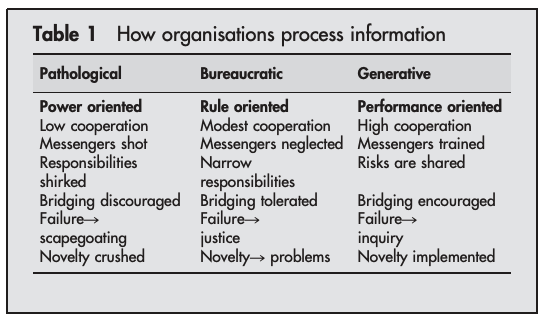Growth culture in Westrum typology terms
Last last year, I stumbled upon the Growth Gurus series of 30 interviews with different leaders in the Insight Partners portfolio. I checked them all out (so you don’t have to), to see if there were any common themes or patterns that looked familiar from these high growth companies. What I discovered was both wonderful and familiar.
There were many, many, interviews where when asked what they have learned about growing companies, leaders responded with a heavy emphasis on the culture of the company. As a long time member and sometime leader in the international DevOps movement, I was thrilled to see even more evidence that culture is a consistent theme for how to be successful in this regard.
“What matters more to me than anything is maintaining the culture that we have. We have this magical spirit that’s encompassed in the phrase, “One team, one dream.” - Neha Sampat, CEO of Contentstack
“Everyone is synced towards what we’re trying to reach and knows every piece of information in that process. That way everyone can move in the same direction quickly because they’re aligned,” - Roy Mann, Founder and CEO of monday.com
“We have always focused on the platform, the product, and processes to flatten the hierarchy. What we try to do is flatten that out as much as we possibly can to make it a collaborative, immersive, cohesive, and efficient culture, so that we can all integrate and develop core product services.“ - Darren Guccione, CEO & Co-Founder of Keeper Security
Westrum typology
In the DevOps Movement we have talked for years about the typology of organizational behavior created by Professor Ron Westrum , especially since the release of the 2019 Accelerate State of DevOps Report and the Accelerate book.
Westrum is discussing medical units in the paper linked above, but we know that his classification system is broadly applicable to local governments and businesses. In his paper he describes types of organizational structures: pathological, bureaucratic, and generative.

Westrum tells us that “The scheme concentrates on information flow as a key variable.” The fascinating thing is that these types of schemes are created by the leaders! This is why I found it so fascinating to see the statements by leaders like Neha, Roy, and Darren above. They weren’t quoting Dr. Westrum, but they were echoing his definition of generative culture nonetheless. The fact that they were being featured as growth gurus shows that their particular philosophies work!
This ties in very well with the learnings from the State of DevOps report.
“Our highest performers are twice as likely to meet or exceed their organizational performance goals.” - 2019 State of DevOps Report
The statements above are endemic of leaders who prioritize the flow of information throughout the organization so that people have the right information in order to help the company grow and succeed. As Westrum explains: “Generative organisations get the needed information to the right person in the right form and in the right time frame.”
The generative organizations focus on 3 key outcomes that result from this optimized flow of information:
- Alignment
- Awareness
- Empowerment
Pierre Naude, CEO of nCino, another Growth Guru explains: “We empower our employees to innovate, share new ideas, challenge old ways of thinking and make decisions that are in the best interest of the customer.“ Or to put it similarly by Westrum: “They are encouraged to speak up, think outside the box, and to act as fully conscious participants in a great cooperative enterprise.”
Westrum goes on to explain: “Information flow is higher in a generative situation, where managers see themselves as coaches rather than commanders.” This reminded me of Turn the Ship Around by Captain David Marquet. Captain Marquet was able to take the USS Santa Fe and in a few short months, turn it from being one of the worst rated submarines in the United States Navy, to one of the top rated. He did this by encouraging information flow throughout the ship. He moved the decisions to where the information was. Sailors were no longer encouraged to be quiet and obey the captain, but instead had the alignment, awareness, and empowerment to contribute to the successful operation of the ship, much like the leaders above.
Get good at delivering software
In the DevOps movement we try to learn lessons from medicine, aviation, nuclear safety, manufacturing, and other disciplines and apply those lessons to the culture of excellence in delivering software. As we’ve seen above, the highest performers at doing this “are more than twice as likely to meet or exceed their organizational performance goals.”
There is a heavy emphasis on information sharing between development, operations, security, quality engineering, and other parts of the organization that allow those companies to meet or exceed those goals. I suspect the emphasis on collaborative culture is one of the things that allows the Growth Gurus to grow so effectively.
This emphasis on culture is so important, I remember distinctly being at one of the early DevOpsDays conferences in Mountain View, CA where John Willis, one of the co-authors of the CAMS (culture, automation, measurement, sharing) model threatened to take the C out of the model when all everyone wanted to talk was DevOps tooling. John reinforced to us how much of a 1st class citizen culture needs to be if we’re truly going to be successful growing our companies using DevOps principles.
When we set out to develop the Service Delivery Assessment at Mangoteque, we took these ideas to heart and made sure that we set out to examine the four key metrics from Accelerate (Deployment Frequency, Lead Time for Changes, Change Failure Rate, and Time to Recover) from the perspective of capabilities which are demonstrated in the culture of an organization, so that we could help companies hasten their journey to become high performers, and thus to grow.
By helping companies become good at delivering software, they are able to more quickly test new features, develop new capabilities, reduce costs, enter new markets, complete acquisitions and other activities that give them a strategic advantage over their competition. The capabilities we highlight are rooted in the importance of alignment, awareness, and empowerment which allows companies to execute quickly and effectively.
As Michael Acton Smith, Co-founder and Co-CEO of Calm, puts it in his interview: “…the reason that we have grown quickly ahead of competitors is largely due to the speed of execution”.
We developed our Assessment to help companies develop a Westrum Generative culture so that they are able to achieve success, growth, and successes in the marketplace. We’re always interested in meeting more people who share this philosophy and enjoy traveling on that path.
“A generative culture will make the best use of its assets, a pathological one will not.” - Ron Westrum, PhD.
